Friday, July 23. 2010
By fabric | ch
-----



As a follow up to our recent post about fabric | ch's installation (Arctic Opening / Fenêtre Arctique) on the Frioul Island in Marseilles, here are some pictures shot during the exhibition.
It has been a quite difficult project to achieve due to hard climatic conditions (40°C all day long during installation and exhibition... This was certainly hard for us, but even more for computers and electronic equipment...), but also due to the fact that the location, size of installation and lighting technology have changed one week prior to opening! ... Definitely not easy to manage...
We thought of this project as a sort of fictional expedition, but it ended up to be a real one! We worked during one week on site to set it up, test, code and modify it. The result was some sort of hypnotic leftover of this experience, running in standalone mode.

 


Interfaces and programs analyze the meteo as well as the lighting conditions north of the Artic Circle, where daytime is permanent at this time of the year (we were still close to the summer solstice in the Northern Hemisphere). These illumination conditions were then channeled (though a LED based large "window-display") to the Frioul Island to light up a piece of its deserted landscape. This distant light appears only at sunset in Marseilles and until sunrise.
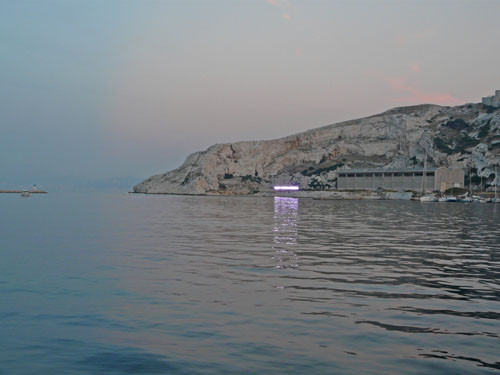
 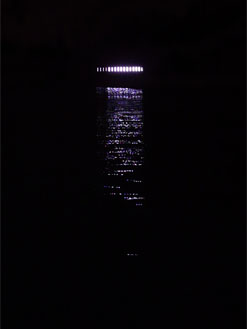

.jpg)

 


.jpg)

Pictures: Frank Petitpierre, Nicolas Besson, Leticia Carmo, fabric | ch
--------------------------------
Project, conception and programmation: fabric | ch
Ligths: Lumens8
On site supervision: Etienne Fortin, AMI
MIMI Direction: Ferdinand Richard, AMI
Curatorship: Pierre-Emmanuel Reviron, Seconde Nature
With the support of Marseille-Provence 2013, MIMI Festival and Lumens8. Arctic Opening is a MIMI 2010 creation by fabric | ch.
Via ArchiDaily
-----

Open Section © The CoDAF
Brent Vander Werf’s Compliant Shading Enclosure creates a movable mechanism within the air-gap of a glass enclosure to regulate the amount of sun, shade and shadow permitted in a space. Powered by the energy from the sun, the mechanism passively expands or closes to make the opening the correct size to meet the desired comfort level.

Open to Closed Series © The CoDAF
The shading system utilizes a bi-metal element that is bonded to high expansion and low expansion alloys. A slight change in temperature makes the alloys produce an opposing force, causing the element to deform and rotate. The system requires no maintenance or user input once installed, and by adjusting the parameters of the alloys, the mechanism can suit a variety of climates.
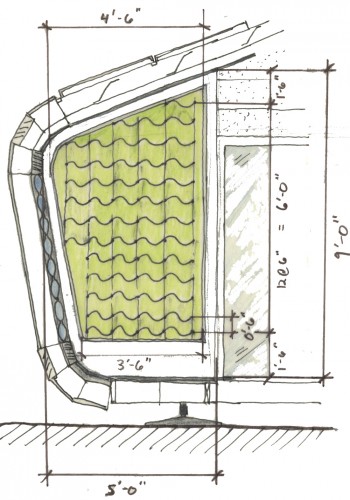
Building Section Closed © The CoDAF
“By placing the bi-metal element within a sealed glass enclosure, like may double pane window systems, an increased amount of temperature change can be obtained due to the greenhouse effect and a passively actuated heat sensor is achieved with a wide range of rotational motion and force exertion. The actuator is then coupled with a bistable mechanism, or an elastic element which produces spring-like characteristics by storing and releasing kinetic and potential energy, thus snapping the aperture and attached shading membrane closed with maximum heat input and vice versa, snapping the aperture back open as heat input diminishes significantly, opening the aperture once again to what’s beyond the glass,” explained the designer.

Mid Section © The CoDAF

Closed Section © The CoDAF
-
 - © The CoDAF
-
 - © The CoDAF
-
 - © The CoDAF
-
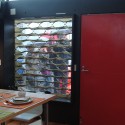 - © The CoDAF
-
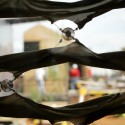 - Photo by Stefano Paltera/US Dept. of Energy Solar Decathlon © The CoDAF
-
 - Open to Closed Series © The CoDAF
-
 - Open Section © The CoDAF
-
 - Mid Section © The CoDAF
-
 - Closed Section © The CoDAF
-
 - Building Section Closed © The CoDAF
-
 - Building Section Open © The CoDAF
Thursday, July 22. 2010
Via Mashable -----
by Jolie O'Dell

A group of researchers from Northeastern University and Harvard University have gathered enough data from Twitter to give us all a snapshot of how we Americans feel throughout a typical day or week.
Not only did they analyze the sentiments we collectively expressed in 300 million tweets over three years against a scholarly word list; these researchers also mashed up that data with information from the U.S. Census Bureau, the Google Maps API and more. What they ended up with was a fascinating visualization showing the pulse of our nation, our very moods as they fluctuate over time.
The researchers have put this information into density-preserving cartograms, maps that take the volume of tweets into account when representing the land area. In other words, in areas where there are more tweets, those spots on the map will appear larger than they do in real life.
It will surprise almost no one to learn that findings indicate a general mood slump mid-day and mid-week, when we are most likely to be at work. Our tweets show that we’re happiest in the early morning and late evening; during the week, our mood tends to peak on Sunday morning.
Less predictable, perhaps, is the fact that West Coast tweets were “happier” than tweets from the East Coast. Although West Coast Twitter users expressed emotions in the same cycles as the East Coast users (with a three-hour gap, of course, because of time zone differences), the West Coasters didn’t dip as low in mood as the East Coasters by a significant margin.
For the inforgraphic fans among you, here’s a lovely PDF showing some of the data displayed:
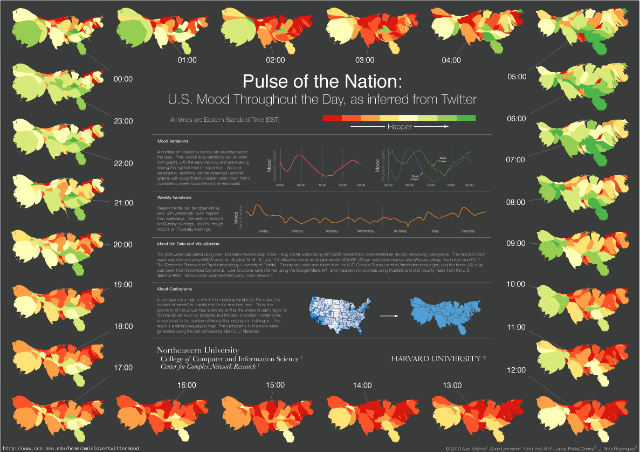
And here’s a cool video showing the American Twitter mood expressions changing over the course of a day:
Via e-flux
-----
Yerba Buena Center for the Arts

Eames Hack Chair by Eames Hacks
Andrew McCandlish, Tom Reynolds, Jared Delorenzo, Alexandra Powell, Tim Peet and Alie Thomer.
Photo courtesy of fuseproject
TechnoCRAFT
Hackers, Modders, Fabbers, Tweakers and Design in the Age of Individuality
July 10 – October 3, 2010
Yerba Buena Center for the Arts
701 Mission St., San Francisco, CA 94103
www.ybca.org
Curated by Yves Béhar
The history of craft and design began with individuals making what they could not afford to buy, which created a deep and personal connection between owner and object. With the Industrial Revolution, the tradition of craft mostly disappeared as people became enamored with the abundance and affordability of mass-produced, high-quality goods. The rise of mass-production and mass-consumerism undeniably elevated the average person’s quality of life. However, the cultural sameness that materialized, combined with the loss of individual connection to objects, left many feeling dissatisfied. As a result, they took matters into their own hands.
A resurgence of the individualization of what we consume is in the works today; it spans functions, ergonomics and appearance. The new “makers and craftsmen” range from the everyday person to the tech entrepreneur, from the young, curious designer to the multinational corporation focused on custom solutions. This new breed shares a sense of "making" and openness to collaboration while operating in a more individualized marketplace, which raises the question – Are we in the midst of a new age in manufacturing and mass-consumption on an individual scale?
TechnoCRAFT highlights the disappearance of the traditional boundary between the role of the designer and that of the consumer. In doing so, it traces the current movement in design away from fixed objects, toward open "design platforms" that invite people to participate in the creative process in a collaborative way. The exhibit focuses on the following six themes:
Crowdsourcing mines the collective talent of the community to develop new design solutions. From product generation to the voting process, crowdsourcing puts the decision-making power in the hands of the masses.
Platforms consist of designers creating open, software-based systems that provide the tools for individuals to create and/or customize their own unique products. From shoes to t-shirts to fantastic creatures, platforms make it easy for individuals of all skill levels to take on the role of designer.
Blueprints are ideas that are replicable, putting the power to create in the hands of the consumer. Rather than creating and selling a finished product, designers sell or give away the instructions so that anyone can create/recreate the design in their own way.
Hacks is a term that has moved far beyond the manipulation of computer software, extending into the public’s consciousness. Tables, iPhones and bikes are revised, modified and manipulated to achieve a new look or new functionality.
Incompletes are works that intentionally leave room for creativity on the part of the user. The degree to which the end user is involved varies with each design, but all depend on the role of the user to provide input for a design to properly function.
Modules are individual components that come together to create customized creations. Intelligently designed modules allow for the user to develop an outcome that is driven in equal parts by ingenuity and budget.
The works on display in TechnoCRAFT span the design spectrum from intentional collaborations between designer and user to outsider hacks, where "finished" products are adapted or modified. Special attention is given to products that embody the intersection of technology and craft that has enabled new and unprecedented levels of user participation which will have profound implications for the future of design and experience making.
Wednesday, July 21. 2010
Via It's Nice That
-----
by Alex

Aaron Rayburn and a band of seventeen other Portland-based creatives set themselves the task of creating a collaborative project as a single unit, and the results are magnificent. Their outcome, on display at the Littman Gallery is a giant piece of type using 14.2 miles of string, outlining 25 letters on 2,500 eyelets, strung by hand. Aaron explained things a little more, and also sent us through some more pics… (Read more)
Flickr Link
|












.jpg)





.jpg)





















